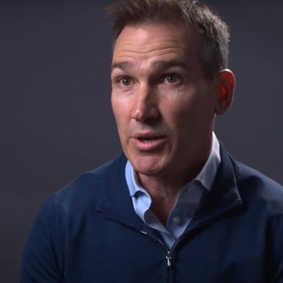Episode Transcript
[00:00:02] Speaker A: Where did the idea for the Dispersion index come from and how was it developed?
[00:00:07] Speaker B: The Dispersion index originated with just talking to traders on the Flora SIBO and realizing that some of the most successful traders of options were guys that were trading index options and individual equity options. And they would often find themselves just as the nature of order flow, they would find themselves where they were selling index options and buying individual equity options. So you could imagine people buying puts for insurance on the OEX or the S and P 500, and then other people that would be doing things like covered calls on the individual equities.
[00:00:47] Speaker C: Right.
[00:00:48] Speaker B: That type of trade wound up being fairly popular and fairly profitable for some of the larger market makers on the floor of CBOE. The second one was when I first started in the business, goldman Sachs used to do it a lot, where they would do equity derivative research reports, where when OEX options were big, they would explain volume changes in OEX options and individual equity options in terms of which trade was cheaper in relative value volatility.
[00:01:18] Speaker C: Right.
[00:01:19] Speaker B: If individual equity options were cheaper for volatility purposes, they would recommend trades in individual equities. If it were the other way around for indexes, they'd recommend index option trades. And you would see that type of order flow happen on the back of reports like that where people were trading between the two. So that's where the idea kind of originated for me. And then just talking with guys like Tim and people who were kind of excited about the topic as well, it just only made it a more natural thing for us to pursue together.
[00:01:54] Speaker A: Tim, how did the SIBO Innovation Lab and Dow Jones indices work together to develop this index?
[00:02:00] Speaker D: This would be a concept that the market would be interested in if we could build it, first of all. Second of all, that it would be better if we could do it together in the sense that our sense of what the marketplace really wanted is they wanted something that could tap into the ecosystem that surrounds the S and P 500 and the kind of global reach and presence that that US. Equity index has, but also have the know how, the expertise, the technology that SIBO Labs and SIBO for even longer had developed around index options, options liquidity VIX. And that the right thing to do this, the right way to do this was to essentially do it as an integration of those two components SP 500, VIX, SAP Indices, SIBO.
[00:02:53] Speaker B: I would agree. Part of developing a successful product, in my mind is having a good partner. I mean, there's a lot of effort that went into developing the way that the Dspbx is selected, the components of it, and even talking about how many iterations we went through before we came up with, yes, this is how we're going to calculate Dspx. The dispersion index.
You know, it was seamless between Tim and a lot of people on the index committees at S P and the people in SIBO Labs in terms of sharing ideas, back, testing different index results, talking about index methodologies, writing up how we thought people would use this index, what the use cases were for meeting with market participants. It was a very close partnership, and it made it fun to work on.
[00:03:52] Speaker A: What are the education efforts to promote the index, and what does the ramp up look like? Until we have a Tradable product, the.
[00:03:59] Speaker B: Dspx index calculation actually goes live tomorrow, so that's the first day that the spot index value will be going out, and you can expect increasing levels of sophistication in terms of the content that S P and SIBO either individually or jointly produce.
Talking from the beginning about what is Dspx, what is it meant to measure, when is it high, when is it low, what are the use cases for it?
And I think that Tim and Mandy Zhu from SIBO relatively new hire in terms of product intelligence, are going to put out some really great content probably between now and the next three to six months. With regard to getting to a Tradable product, a very strong goal of ours is to, by the end of the second quarter, have a very good idea for a launch date for a cash settled future on the Dspx index itself. And all of that is obviously subject to regulatory approval and being able to do all of the development work on CFE that we need to in order to support the future's launch.
[00:05:16] Speaker D: We want to invest in education and understanding here. And that goes all the way back, actually to almost a year ago, I should say. We announced an academic grant, $50,000, that was just an open academic grant. People, please come and research dispersion, the applications of dispersion, the usage of dispersion in a market environment. Both organizations are building out what will be, as John says, content on a range of sophistication and frequency. In the short term, our focus is really more on what is it, what does it tell you? That's probably our first challenge is to give the market a sense of what a dispersion index level of 20 means. 30 means, 40 means, what it means for their portfolio, what it means for their opportunity set in a way that I think with VIX, people already have that sense, the very keen sense of what it means for VIX to be at ten or at 50.
[00:06:12] Speaker A: What is the nickname for the index?
[00:06:14] Speaker D: I work for an index company. One of the things that we do is publish a regular report under the brand name Spiever, which looks at how many traditional stock picking active managers beat the S and P 500 every year. And if you've seen the report, one of the things that's quite striking about it is over the very long term, it appears to be quite difficult to beat the SP 500 through stock picking. And we thought, well, maybe this isn't just anything to do with the skill or luck of the managers. Maybe it's to do with the opportunity set. And we started to look at realized dispersion. How much difference was there between winners and losers at the stock market? And we discovered that actually, this is a number that changes materially in periods like COVID, or the emergence of COVID period, or the technology bubble of the 2000s. Huge rewards, huge dispersion, huge opportunity for outperformance, and I should say opportunity for embarrassment as well. But for long periods, 2013 through 2017, for example, or 2016, just no dispersion, everything was swimming together, no opportunity for outperformance dispersion tells you. And the way we've built this index, it's essentially it's an indicator for what's? The value or the reward for successful stock picking? What is the opportunity set going to be over the next month for skillful stock selectors? And so, while VIX is the fear index, we wonder if this might not be appropriately monitored as the opportunity index.
[00:07:45] Speaker A: How are traders going to use the index once it begins to trade? And how would it relate to using the VIX?
[00:07:52] Speaker D: This is part of the risk landscape, and there is a community of investors that, whether intentionally or unintentionally, have exposure to the levels of dispersion in the market. And so this at its core is about building an index, a market standard, a transparent, something that you can price instantaneously, that isn't biased. Like, we haven't built it so that people want to buy it or people want to sell it. We've built it to try and build a marketplace, and we hope to give people a liquid, transparent, viable mechanism to manage that risk or to take positions.
[00:08:28] Speaker B: That idea for a quick beta to dispersion PNL is certainly a use case for any standardized future, assuming that we get appropriate levels of liquidity so that people can trade it. It's also the case that the way that we've designed the index, in terms of it being a relatively short measure of dispersion, it's a 30 day measure of expected dispersion of the S and P 500 has some interesting properties in itself. When you look at the way that companies report earnings on a quarterly cycle, it is the case that there'll be seasonality within Dspx, right? If it's the case that the spot index, looking forward 30 days, covers a period of earnings announcements for individual equities, the Dspx in terms of its performance throughout the year will be relatively high. If the next month is a time when you don't expect a lot of earnings announcements, the Dspx on a relative basis will be low. So you'll see this seasonality associated with the reporting of earnings, and that has implications for the pricing of a derivative that settles to Dspx, right? One of the things that you could think of in terms of volatility trading is the offsighted decay that you see in buying VIX futures?
[00:09:54] Speaker C: Right.
[00:09:55] Speaker B: The expensiveness of the role of the front two months of VIX futures. If it's the case that four times out of the year a Dspx level is going to be seasonally high, you would expect that in those four times out of the year that you would observe backwardation in the futures price.
[00:10:14] Speaker C: Right.
[00:10:14] Speaker B: So it would be the case that you could, on a relative to VIX basis, obtain a long volatility position with a lower cost of carry.
[00:10:25] Speaker D: If you take a step back, how is this index built? What does it do? Essentially it's about the difference of the prices overall for options in single stocks versus the prices for options in the index. I e. The price of the options of their combination. But what drives it? Is that difference like which is more rich? Is it single stock options or is it index options and long or short dispersion or trades that are built along those lines are incredibly difficult to implement. In practice, you need so many options and you need to really high degree of maintenance. And this gives you an easy way potentially to look at and think about the cost to transfer risk from index to constituents and back again. And that has use cases that really span the gamut from relative value to market making to hedging to also just improving price quality in indications of market conditions to the options market in general.
[00:11:24] Speaker A: Are there opportunities in longer term structures than just the 30 days?
[00:11:28] Speaker D: Potentially. What will probably serve the market better is if we focus on one index and where there is trading interest or product interest, try and concentrate liquidity, certainly in the early days, but your question is an apt one and I think that there certainly is a term structure and so there is value in looking into it. In theory, if there were, if you get the approvals and there is a futures term structure, I think we're both excited to see what that looks like.
[00:11:56] Speaker A: With the popularity of zero day to expiration of options, how do they play into the dispersion index?
[00:12:02] Speaker B: In my opinion, the jury is somewhat still out on the impact of zero DTE on the volatility levels in S and P 500 index options.
[00:12:12] Speaker C: Right.
[00:12:13] Speaker B: How much of the trading in zero DTE is influencing the term structure of SPX options?
There are a lot of opinions out there, mine's just one of them because those positions tend to be so short term in that you start trading that option on the day it expires and then it expires its impact on front month, 30 day out split volatility. And whether or not it's dampened the levels of the VIX, I think is a difficult claim to support.
What that means in terms of our product, in terms of talking about Dspx, I think the only way that you could see it factoring into Dspx is straight through the VIX. I mean, what we're doing is the average single name vault the difference between that and the VIX itself.
[00:13:08] Speaker C: Right.
[00:13:09] Speaker B: So if it was the case that zero DTE had a Measurable effect on the VIX, it could have some effect on Dspx. We haven't gotten to the time where there's same day trading expiration that phenomena in single names, the same that it is for SBX.
[00:13:29] Speaker C: Right.
[00:13:30] Speaker B: Interestingly, in putting together the index even, right. It's the question of when you calculate a 30 day number for the single names, do you allow the use of weekly options? And when you look at it and study it for the index like we did, the use of single name weekly options is not as universal as what you see in the SPX today.
[00:13:52] Speaker C: Right.
[00:13:53] Speaker B: That weekly phenomenon is kind of an SPX and a spy thing more than it is a single name option thing.
[00:13:59] Speaker A: Does the Dispersion index lend itself to any kind of sub indexes?
[00:14:03] Speaker B: This is a plug for another index that I came up with at SIBO or SIBO Labs came up with. And it's the idea that hand with vault and Dispersion is a measure of the correlation of the stocks of the S and P 500.
[00:14:18] Speaker C: Right.
[00:14:18] Speaker B: And so that's another way to get at something like Dispersion. It's a less tradable index level. And that's why we created implied correlation and then we created a Dispersion index to provide a tradable product on that type of risk.
[00:14:36] Speaker C: Right.
[00:14:37] Speaker B: The implied correlation for one month has a ticker symbol of cor one M, and so we do that slightly differently than we do the Dspx. But in terms of kind of sister or sibling index to Dspx and VIX correlation, implied correlation would be the thing that I would look at because correlation ties Dispersion and volatility together.
[00:15:07] Speaker A: When you get a great idea in the SIBO Innovation Lab, how do you celebrate it?
[00:15:11] Speaker B: We have a daily stand up and then we also have periodic meetings where it's a bigger group of people and most of the time it involves getting people in the room with a whiteboard and somebody presents an idea and we all try and shoot holes in it. So there are a lot of carcasses along the way, but there are some really good ideas. I can't imagine us stopping with trying to describe the risk of North American equities through the SPX at just Dspx and VIX and correlation.
[00:15:42] Speaker C: Right.
[00:15:43] Speaker B: A lot of people ask questions about what is the liquidity that is underlying the S and P 500? And to me that's a fascinating story because there's only one successful volatility derivative product out there in my mind that's just pure volatility, and that's the VIX. And I don't think that that's by chance.
[00:16:06] Speaker C: Right.
[00:16:06] Speaker B: The S and P 500 is what I think of when I think of equity markets in North America SPX options are what I think of when I think of how to trade optionality on the S and P 500 and VIX is what I think of when I think of trading pure volatility. So if I were going to develop a product on dispersion, I would start with that ecosystem.
[00:16:30] Speaker C: Right.
[00:16:31] Speaker A: What do you think is the probability of success for this product?
[00:16:34] Speaker B: I would consider it a success if we were trading right around the equivalent of 100,000 futures. So a fraction of what we do with the VIX future. If the VIX future is trading 200,000 contracts a day and Dspx futures were trading 100,000 contracts a day, I'd be very happy and thought we did a very good job on that.
[00:16:55] Speaker D: In terms of ambitions, that's probably, yes, optimistic, but realistic. And I would anticipate that they probably grow both together in the sense that there's a useful way in which one makes the other more useful, I think, beyond the success of the contract, which, of course, would be a SIBO product. And then here is the index provider. I think there's also a real value in just adding more useful, genuinely useful, transparent, well calculated, well built indices that give you information about where risk is, where prices are in the market today. In that sense, Dsbx will be useful if people use it. The grounds for success do seem to be laid, does seem to be a product or an index that's coming out at the right time. People are interested in dispersion. It's resonating so early days, but encouraging signs.
[00:17:48] Speaker A: For more stories like this one, visit John Lothiannews.com.


